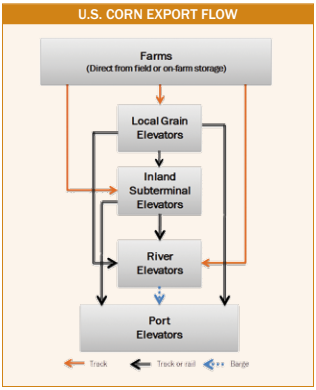U.S. Corn Export Flow
As corn is harvested, farmers transport grain to on-farm storage, end users or commercial grain facilities. While some producers feed their corn to their own livestock, the majority of the corn moves to other end users (feed mills or processors) or commercial grain-handling facilities, such as local grain elevators, inland subterminals, river elevators and port elevators. Local grain elevators typically receive most of their grain directly from farmers. Inland subterminals or river elevators collect grain in quantities suitable for loading on unit trains and barges for further transport. These elevators may receive over half of their corn from other elevators and are often located where the transport of bulk grain can be easily accommodated by unit trains or barges. Local grain, inland subterminals and river elevators provide functions such as drying, cleaning, blending, storing and merchandising grain. River elevators and the larger inland subterminals supply most of the corn destined for export markets. The figure to the right conveys the flow of U.S. corn destined for export markets.
